Abstract
The paper discusses the operation of wireless sensor networks consisting of nodes based on the IEEE 802.15.4 ZigBee transceiver operating in the presence of Rayleigh or Nakagami-m fading, additive white Gaussian noise (AWGN) and interference. Analytical expressions for bit error rate (BER) for the IEEE 802.15.4 network were obtained when Rayleigh and Nakagami-m fading were processed with a selection-combining (SC) and maximum-ratio-combining (MRC) combiner and when AWGN and interference were present. Analytical results are presented graphically in the form of BER change, depending on the signal-to-noise ratio (SNR) for different values of network parameters: fading parameter (m), number of branches of MRC combiner (L), modulation parameter (M), and spreading sequence lengths (Lc). Graphical results are presented for the system when there are no combiners and when the SC and MRC combiners are included. Numerical results were confirmed by Monte Carlo simulation. Analysis of the SC and MRC combiner application impact on the performance improvement of the IEEE 802.15.4 network and the received signal was performed.
1. Introduction
The Institute of Electrical and Electronics Engineers (IEEE) 802.15.4 [1] is a technical standard that defines the operation and implementation of wireless sensor networks (WSNs). IEEE 802.15.4 takes center stage in the Internet of Things (IoT) as low-rate wireless personal area networks (LR-WPANs) [2]. Wireless sensor networks consist of a large number of sensor nodes that are multifunctional and have a limited energy source; therefore, energy must be used efficiently [3]. From the energy efficiency point of view, insufficiently accurate performance estimation is likely going to cause energy loss due to retransmission in automatic repetition schemes or additional processing, due to coding and decoding, in forward error correction schemes. Along with worsened energy efficiency, fading, interference and noise negatively affect other parameters critical for normal network operation, such as latency and throughput. Therefore, an accurate network performance evaluation in the given transmission conditions is extremely valuable when deciding on many networks’ specific parameters, such as distribution of the transmission power per node, the network node density, selection of error correction scheme, etc. [4].
IEEE 802.15.4 networks use several bands, among which the most popular is the 2450 MHz Industrial-Science-Medicine (ISM) band [5]. Signal transmission in wireless networks can be attenuated by noise, fading and interferences. These disturbances can cause changes in the transmitted signal to the extent that the receiver fails to correctly recognize the received symbols. Fading channels can be modeled through Nakagami-m, Rayleigh, Ricean, k-μ distribution and others [6,7]. The reliability of the communication connection is most often reflected in the value of the bit error rate (BER) in the receiver [8]. Instead of analyzing corrupted packets or packet error rates only, the BER and related error patterns provide more in-depth insights into how the transmitted sequence is detected by the receiving node and translated back to the corresponding symbol [9]. In addition, there are other performances based on which the quality of the communication connection is assessed, such as bit error probability (BEP), packet error rate (PER) and chip error probability (CEP) [9].
Although the IEEE 802.15.4 standard uses the carrier-sense medium access with collision avoidance protocol (CSMA/CA) as a method of mitigating interference, collisions cannot be completely avoided. The CSMA/CA mechanism does not provide sufficient protection against problems caused by hidden nodes that are the root cause of co-channel interference (CCI). However, they have the ability to receive signals correctly despite a significant level of CCI [10,11].
Spatial diversity techniques are used to reduce the impact of large-scale and small-scale fading on the system performance in radio frequency (RF) channels. The most widely used is the spatial diversity technique with multiple antennas at the receiver input. Signals from antennas are combined in different ways. The combination techniques used to reduce the fading impact on the system performance are maximum-ratio combining (MRC), equal-gain combining (EGC), selection combining (SC) and switch-and-stay combining (SSC) [12,13].
Numerous papers deal with the issue of received signal quality in IEEE 802.15.4 networks [5,9,10,14,15,16,17]. In [16], the performance of the ZigBee network under WiFi interference was considered and presented through the terms for PER and BER. In [17], the PER of the ZigBee under a wireless local area network (WLAN) and Bluetooth interferences was analyzed. The impact of fading was not considered in these papers. Performance analysis of the IEEE 802.15.4 network in the form of BER, and under the impact of Rayleigh and Nakagami-m fading and in the presence of additive white Gaussian noise (AWGN) and interference is presented in [18]. An analytical CEP expression in IEEE 802.15.4-based networks operating in the presence of AWGN, interference and multipath fading has been derived in [9].
In this paper, the performance of an IEEE 802.15.4 network operating under the impact of Rayleigh and Nakagami-m fading, in the presence of AWGN and interference, are considered. In order to reduce the impact of fading on the signal quality degradation, SC and MRC diversity techniques for reducing the impact of fading in the network were used. To the best of the authors’ knowledge, there are no similar analyses or results presented in the available literature.
The main contributions of this paper are:
- Analytical expressions for the BER of the received signal in the IEEE 802.15.4 network operating under the impact of SC and MRC diversity, in the presence of Rayleigh and Nakagami-m fading, as well as AWGN and interference.
- Numerical results are presented in the form of graphs, and the results are confirmed by Monte Carlo simulation. A comparative analysis of the SC and MRC combiner impact on the received signal quality is given.
- Derived expressions are the basis for obtaining other system performance such as CEP, symbol error probability (SEP) and packet error probability (PEP).
The organization of this paper is as follows: Section 2 presents the system model under consideration. Section 3 gives the BER calculation procedure for the case in which SC combiners are used to reduce the impact of Nakagami-m and Rayleigh fading on the system performance in the presence of AWGN and interference. Section 4 gives the BER calculation procedure for the case in which MRC combiners are used to reduce the impact of fading. Numerical results for different scenarios and parameters are presented in Section 5. The conclusion is in Section 6.
2. System Model
BER of an IEEE 802.15.4 ZigBee transceiver can be defined as [18]:
where M denotes M-ary signaling, and is the received instantaneous SNR (Eb—the bit energy, N0—the noise power spectral density).
BER expression in an environment involving interference can be obtained as [18]:
where T is defined by [18]:
where Lc denotes spreading sequence lengths whose characteristic values are 32 chips, 64 chips, 128 chips, k—number of bits per symbol, Tb—bit duration, and Pi—the received power level of interference.
The average probability of error for the fading channel can be computed by integrating over a fading distribution. Therefore, the BER can be achieved by averaging the conditional error probability with respect to the instantaneous SNR, γ, as follows [18]:
where f(γ) is the probability density function (PDF) of γ for the fading channel at the output of the SC or MRC combiner.
In this paper, two cases of fading are considered—Rayleigh and Nakagami-m—defined respectively in [19]:
where γ0 is the mean value of the received SNR (ratio of the signal energy per bit to noise spectral density) defined as , where is the mean square value of the Rayleigh/Nakagami-m distributed random variable α, m denotes the fading parameter, and Γ(·) represents the Gamma function.
3. BER in the Case of an SC Combiner
The SC receiver (combiner) is used to reduce the impact of fading on the system performance. The signal at the output of the SC receiver is equal to the maximum of the signal at its inputs. The SC receiver can have two, three, or more inputs. The SC receiver is simpler for practical implementation than the MRC and EGC receivers and therefore has a large application [12,20]. The SC combiner with two inputs can be represented as in Figure 1, where γ1 and γ2 are SNRs of signals at the input and γ the SNR of the signal at the output.
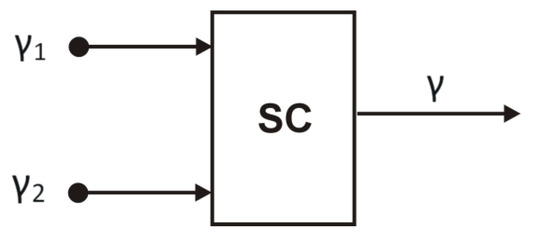
Figure 1.
SC combiner with two inputs.
The PDF of the signal at the output of the SC combiner can be represented as [21]:
where f(γ) is given by (5) and (6), and the cumulative distribution function (CDF) F(γ) by:
where f(t) is given by (5) and (6) for the Rayleigh and Nakagami-m distribution, respectively.
3.1. BER in the Case of SC Combiners for Rayleigh Fading Channels
Substituting (5) into (8) and solving the integral gives the CDF for the Rayleigh fading channel. By substituting the obtained solution for (8) and (5) in (7), the PDF is obtained at the output of the SC combiner for the case of the Rayleigh fading channel:
The BER of the WSN transceiver based on ZigBee technology operating in an AWGN environment and with a signal under impact of Rayleigh fading, previously passed through an SC combiner with two branches, is obtained when (9) and (2) are included in (4):
By use of the transformation for the erfc(·) function [22] Eq. (06.27.26.0006.01) and the transformation for exponential function [23] Eq. (8.4.3), integral I10.1 reduces to the following form:
where G(·) is the Maijer G-function. By using [24] Eq. (07.34.21.0011.01), integral I10.1 obtains the following solution:
By using the same transformations as for solving the integral I10.1, the solution of the integral I10.2 is reduced to:
By using the transformation for the erfc(·) function [22] Eq. (06.27.26.0006.01) and the transformation for the exponential function [25] Eq. (1.211.1), integral I10.3 reduces to the following form:
By using [24] Eq. (07.34.21.0011.01), integral I10.3 obtains the following solution:
By using the same transformations as for solving the integral I10.3, the solution of the integral I10.4 is reduced to:
After substituting the integral solutions (12), (13), (15) and (16) in (10), the final expression for the BER of the transceiver of the IEEE 802.15.4 network operating in an environment with AWGN and with a signal impacted by Rayleigh fading, previously passed through an SC combiner with two branches, is obtained:
3.2. BER in the Case of SC Combiners for Nakagami-m Fading Channels
By substituting (6) into (8) and solving the integral by using [25] Eq. (3.351.1) the CDF for Nakagami-m fading channels is obtained:
Substituting (6) and (18) into (7), the PDF is obtained at the output of the SC combiner for the case of the Nakagami-m fading channel:
The BER of the WSN transceiver based on ZigBee technology operating in an AWGN environment and with a signal under the impact of Nakagami-m fading, previously passed through an SC combiner with two branches, is obtained when (19) and (2) are included in (4):
By using the transformation for the erfc(·) function [22] Eq. (06.27.26.0006.01) and the transformation for the exponential function [23] Eq. (8.4.3), as well as by using [24] Eq. (07.34.21.0011.01), integral I20.1 obtains the following solution:
By using the transformation for the erfc(·) function [22] Eq. (06.27.26.0006.01) and the transformation for the exponential function [25] Eq. (1.211.1), as well as by using [24] Eq. (07.34.21.0011.01), integral I20.2 obtains the following solution:
By using the transformation for the erfc(·) function [22] Eq. (06.27.26.0006.01) and the transformation for the exponential function [23] Eq. (8.4.3), as well as by using [24] Eq. (07.34.21.0011.01), integral I20.3 obtains the following solution:
By using the transformation for the erfc(·) function [22] Eq. (06.27.26.0006.01) and the transformation for the exponential function [25] Eq. (1.211.1), as well as by using [24] Eq. (07.34.21.0011.01), integral I20.4 obtains the following solution:
After substituting the integral solutions (21), (22), (23) and (24) in (20), the final expression for the BER of the transceiver of the IEEE 802.15.4 network operating in an environment with AWGN and interference, impacted by Rayleigh/Nakagami-m fading, with an SC combiner with two branches, is obtained as:
4. BER in the Case of MRC Combiners
MRC gives the greatest diversity profit, but these combiners are very expensive with respect to practical realization. MRC receivers can have two, three, or more inputs. If the noise power is the same at all inputs, then the square of the signal at the output is equal to the sum of the squares of the signal at the inputs. The distribution that the signal has at the input of the MRC receiver is the same as at the output of the MRC receiver, and the average power increases in proportion to the number of inputs [12,20].
The MRC receiver with L inputs can be represented as in Figure 2, where γ1, γ2, …, γL are the SNR of signals at the input and γ is the SNR of the signal at the output.
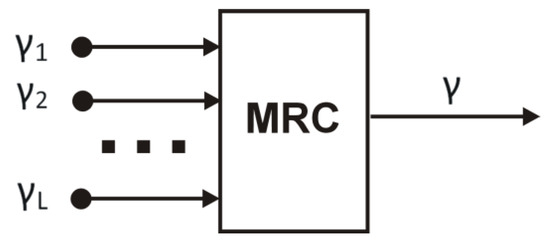
Figure 2.
MRC combiner with L inputs.
4.1. BER for MRC Combiner in the Presence of Rayleigh Fading
The PDF of the signal at the output of the MRC combiner where Rayleigh fading is present at the input can be represented as [26]:
The BER of the WSN transceiver based on ZigBee technology operating in an AWGN environment and with a signal under the impact of Rayleigh fading, previously passed through the MRC combiner with L branches, is obtained when (26) and (2) are included in (4):
By using the transformation for the erfc(·) function [22] Eq. (06.27.26.0006.01) and the transformation for the exponential function [23] Eq. (8.4.3), as well as by using [24] Eq. (07.34.21.0011.01), integral I27.1 obtains the following solution:
By using the transformation for the erfc(·) function [22] Eq. (06.27.26.0006.01) and the transformation for the exponential function [25] Eq. (1.211.1), as well as by using [24] Eq. (07.34.21.0011.01), integral I27.2 obtains the following solution:
After substituting the integral solutions (28) and (29) in (27), the final expression for the BER of the transceiver of the IEEE 802.15.4 network operating in an environment with AWGN and with a signal impacted by Rayleigh fading, previously passed through the MRC combiner with L branches, is obtained:
4.2. BER for MRC Combiner in the Presence of Nakagami-m Fading
The PDF of the signal at the output of the MRC combiner with L branches where Nakagami-m fading is present at the input can be represented as [12]:
that is, as:
The BER of the WSN transceiver based on ZigBee technology operating in an AWGN environment and with a signal under the impact of Nakagami-m fading, previously passed through the MRC combiner with L branches, is obtained when (32) and (2) are included in (4):
By using the transformation for the erfc(·) function [22] Eq. (06.27.26.0006.01) and the transformation for the exponential function [23] Eq. (8.4.3), as well as by using [24] Eq. (07.34.21.0011.01), integral I33.1 obtains the following solution:
By using the transformation for the erfc(·) function [22] Eq. (06.27.26.0006.01) and the transformation for the exponential function [25] Eq. (1.211.1), as well as by using [24] Eq. (07.34.21.0011.01), integral I33.2 obtains the following solution:
After substituting the integral solutions (34) and (35) in (33), the final expression for the BER of the transceiver of the IEEE 802.15.4 network operating in an environment with AWGN and with a signal impacted by Nakagami-m fading, previously passed through the MRC combiner with L branches, is obtained:
5. Numerical Results
All the results are obtained in the form of infinite series, and their truncation is needed. In Table 1, the number of terms to be summed in order to achieve accuracy at the fifth significant digit is depicted for (25), (30) and (36). The calculation was performed for the parameters γ0 = 0, Lc = 32 chips, M = 4, and k = 4. The number of terms required to obtain accuracy on the fifth significant digit decreases for higher values of the parameter m (in the case of the Nakagami-m model—Equations (25) and (36)). The number of terms required to obtain accuracy at the fifth significant digit is increased for a greater number of branches of the MRC combiner (in the case of the Rayleigh model—Equation (30). In order to obtain accuracy at the fifth significant digit for the SC combiner and the SC combiner, 195 terms are required.

Table 1.
Terms needed to be summed in the expression for cumulative distribution function to achieve accuracy at the fifth significant digit.
By using the calculated analytical expressions (17), (25), (30) and (36), the numerical results of BER depending on the mean value of the received SNR-γ0 are presented. Figure 3 shows the BER behavior for fading channels modeled with the Nakagami-m and Rayleigh distributions, when the signal is processed by the SC and MRC combiners and when there are no combiners (the case analyzed in [18]). The following parameter values were used: Lc = 32 chips, M = 4, k = 4 bits, m = 2 (for the Nakagami-m distribution), and L = 2 (for the MRC combiner).
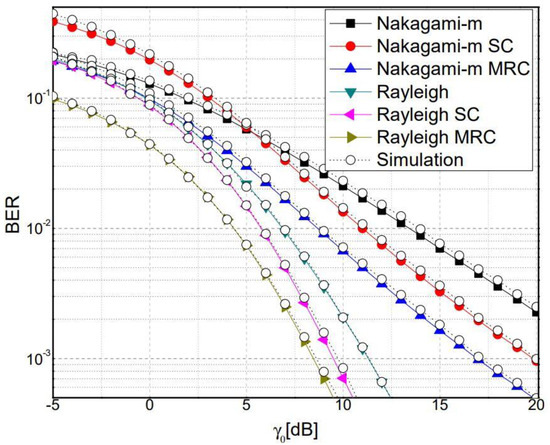
Figure 3.
BER behavior for Nakagami-m and Rayleigh fading channels with and without SC and MRC combiners.
From Figure 3 it can be seen that the BER values decrease with an increasing parameter γ0 and that the Rayleigh fading channel has a better performance than the Nakagami-m fading channel. The application of SC and MRC combiners has the effect of reducing BER and of improving system performance.
Only in the case of using the SC combiner, and for the Nakagami-m fading channel, is poorer performance obtained when the parameter γ0 has lower values. The MRC combiner gives a better performance than the SC combiner. The simulation results fit the numerical results. Simulation results were obtained using Monte Carlo simulation in the MATLAB R2017b software.
Figure 4 shows the BER behavior when using the MRC combiner with a different number of branches. From the given graph it can be seen that the use of MRC combiners gives lower, i.e., better BER values, with better values being significantly more pronounced at lower values of the parameter γ0 and Rayleigh fading channels.
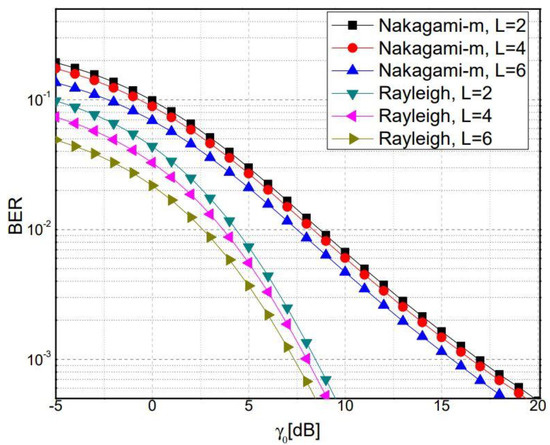
Figure 4.
BER behavior when using MRC diversity combiner.
Figure 5 shows the BER behavior for the case of the Nakagami-m fading channels when no combiners are used and when SC and MRC combiners are used, for different values of the m parameter. Increasing the fading parameter m leads to a decrease in BER. The use of combiners also leads to lower BER values, with the MRC combiner having a greater impact on BER reduction.
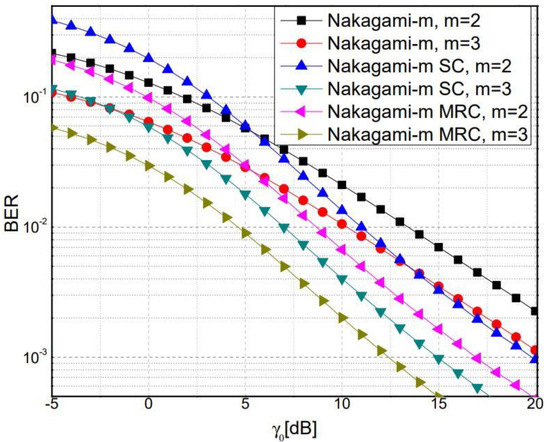
Figure 5.
BER behavior for Nakagami-m fading channels with and without the SC and MRC combiners.
A graphical representation of the obtained analytical results in (17) and (30) is given in Figure 6 and Figure 7, where the BER behavior when using SC and MRC combiners with two branches is shown, for different values of the modulation parameter M for the Rayleigh and Nakagami-m fading channels, respectively. The given results show that increasing the modulation parameter M leads to an increase in BER. The increase in BER is significantly more pronounced at lower SNR values.
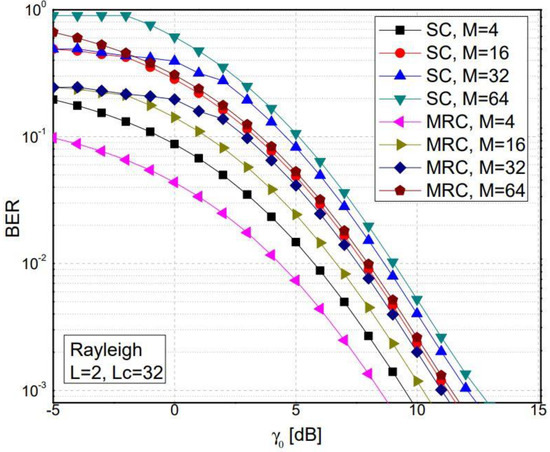
Figure 6.
BER behavior for Rayleigh fading channel using SC and MRC combiners for different values of modulation parameter M.
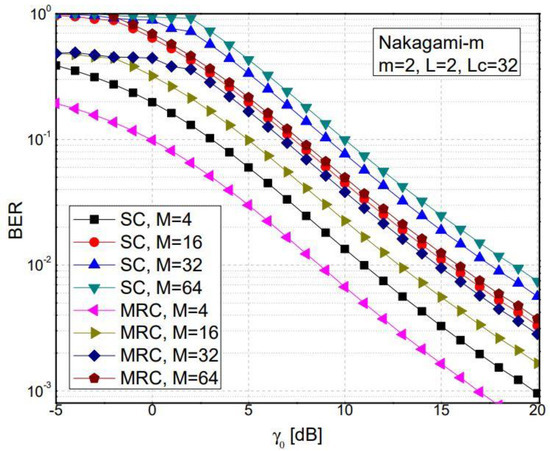
Figure 7.
BER behavior for Nakagami-m fading channel using SC and MRC combiners for different values of modulation parameter M.
A graphical representation of the obtained analytical results in (25) and (36) is given in Figure 8 and Figure 9, where the BER behavior when using the SC and MRC combiners with two branches is shown, and for different values of spreading sequence lengths Lc for the Rayleigh and Nakagami-m fading channels, respectively. The given results show that increasing the spreading sequence lengths Lc leads to a decrease in BER and an increase in the quality of the received signal. The decrease in BER is significantly more pronounced at higher SNR values.
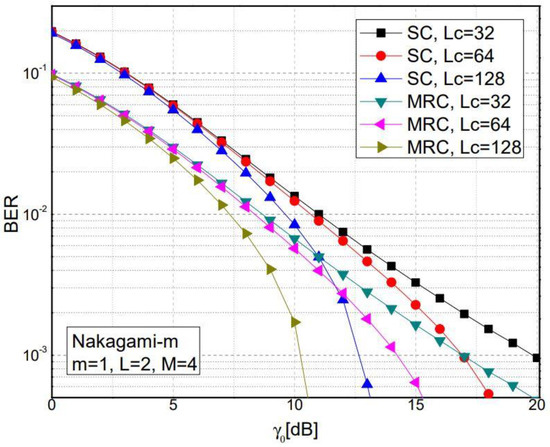
Figure 8.
BER behavior for Rayleigh fading channel using SC and MRC combiners for different values of spreading sequence lengths Lc.
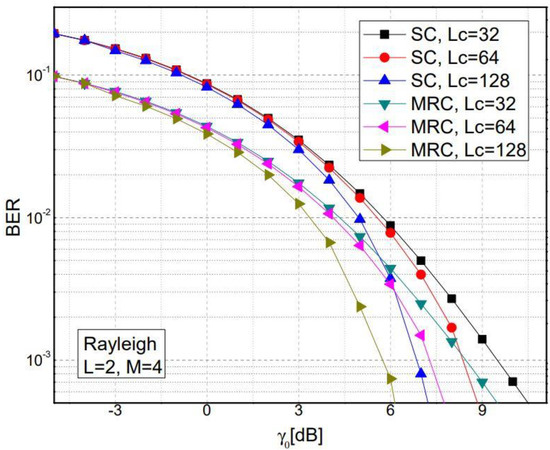
Figure 9.
BER behavior for Nakagami-m fading channel using SC and MRC combiners for different values of spreading sequence lengths Lc.
6. Conclusions
The paper presents analytical expressions for the BER of the received signal in the IEEE 802.15.4 network operating under the impact of SC and MRC diversity in the presence of Rayleigh and Nakagami-m fading, as well as AWGN and interference. Numerical results in the form of graphs are presented. Based on the obtained results, it can be concluded that the BER values decrease with the increasing parameter γ0 and that the Rayleigh fading channel has a better performance than the Nakagami-m fading channel. The application of SC and MRC combiners has the effect of reducing BER and improving system performance. The use of MRC combiners gives a better performance than the use of SC combiners. The use of MRC combiners gives lower BER values, with better values being significantly more pronounced at lower values of the parameter γ0 and Rayleigh fading channels. Increasing the fading parameter m leads to better system performance. There are no drastic performance improvements when using combiners compared to not using combiners. However, due to the specific operation of WSNs in extremely different climatic environments, any improvement is welcome. Systems with combiners are very popular in increasingly common hybrid RF/FSO systems, so the analyzed model is very adaptable for hybrid systems.
Based on the obtained results, the behavior of different implementations of the IEEE 802.15.4 network can be predicted for different values of network parameters and in different propagation environments. This enables the designers of mobile transmission systems to create rational systematic solutions for the desired system performance.
The results presented in this paper can be the basis for future research on the impact of diversity techniques in order to reduce the fading of the IEEE 802.15.4 network, as well as the use of diversity systems with a combination of different numbers of combiners at the micro and macro level.
Author Contributions
Conceptualization, B.J.; Methodology, B.J., J.T. and M.B.; Software, J.T. and M.J.; Validation, M.J.; Writing—original draft, B.J. and J.T.; Supervision, D.B. All authors have read and agreed to the published version of the manuscript.
Funding
This research received no external funding.
Institutional Review Board Statement
Not applicable.
Informed Consent Statement
Not applicable.
Data Availability Statement
Not applicable.
Conflicts of Interest
The authors declare no conflict of interest.
References
- IEEE 802.15.4 Standard for Low-Rate Wireless Networks. Available online: https://standards.ieee.org/ieee/802.15.4/11041/ (accessed on 15 June 2023).
- Zubair, M.A.; Nain, A.K.; Bandaru, J.; Rajalakshmi, P.; Desai, U.B. Reconfigurable Dual Mode IEEE 802.15.4 Digital Baseband Receiver for Diverse IoT Applications. In Proceedings of the IEEE 3rd World Forum on Internet of Things—WF-IoT, Reston, VA, USA, 12–14 December 2016; pp. 389–394. [Google Scholar] [CrossRef]
- Bandjur, D.; Jaksic, B.; Bandjur, M.; Jovic, S. An Analysis of Energy Efficiency in Wireless Sensor Networks (WSNs) Applied in Smart Agriculture. Comput. Electron. Agric. 2019, 156, 500–507. [Google Scholar] [CrossRef]
- Kadel, R.; Islam, N.; Ahmed, K.; Halder, S.J. Opportunities and Challenges for Error Correction Scheme for Wireless Body Area Network—A Survey. J. Sens. Actuator Netw. 2019, 8, 1. [Google Scholar] [CrossRef]
- IEEE 802.15.4 Version 2006. IEEE Standards Association. 2006. Available online: https://standards.ieee.org/standard/802_15_4-2006.html (accessed on 15 June 2023).
- Pesović, U.; Planinsic, P. Error Probability Model for IEEE 802.15.4 Wireless Communication. J. Circuits Syst. Comput. 2016, 25, 1650135. [Google Scholar] [CrossRef]
- Gebali, F. Analysis of Computer Networks, 2nd ed.; Springer: Berlin/Heidelberg, Germany, 2015; pp. 413–441. [Google Scholar] [CrossRef]
- Yigitel, M.A.; Incel, O.D.; Erzoy, C. QoS-Aware MAC Protocols for Wireless Sensor Networks: A Survey. Comput. Netw. 2011, 55, 1982–2004. [Google Scholar] [CrossRef]
- Bandjur, D.; Jaksic, B.; Raicevic, A.; Popovic, B.; Bandjur, M. Performance Analysis of an IEEE 802.15.4 Network Operating under k-μ Fading, Interference and AWGN. Iran. J. Sci. Technol. Trans. Electr. Eng. 2020, 44, 1549–1557. [Google Scholar] [CrossRef]
- Pešović, U.; Planinšič, P. Error probability model for IEEE 802.15.4 wireless communications in the presence of co-channel interference. Phys. Commun. 2017, 25, 43–53. [Google Scholar] [CrossRef]
- Lu, J.; Whitehouse, K. Flash Flooding: Exploiting the Capture Effect for Rapid Flooding in Wireless Sensor Networks. In Proceedings of the 28th Conference 535 on Computer Communications—INFOCOM 2009, Rio de Janeiro, Brazil, 19–25 April 2009. [Google Scholar]
- Panic, S.; Anastasov, J.; Stefanovic, M.; Spalevic, P. Fading and Interference Mitigation in Wireless Communications; CRC Press: Boca Raton, FL, USA, 2013. [Google Scholar]
- Krstic, D.; Jaksic, B.; Gligorijevic, M.; Stefanovic, D.; Strefanovic, M. Performance of Diversity System Output Signal in Mobile Cellular System in the Presence of α-μ Short Term Fading and Gamma Long Term Fading. Radioengineering 2016, 25, 757–762. [Google Scholar] [CrossRef]
- Nithya, V.; Ramachandran, B.; Bhaskar, V. Energy and Error Analysis of IEEE 802.15.4 Zigbee RF Transceiver under Various Fading Channels in Wireless Sensor Network. In Proceedings of the International Conference on Advanced Computing—IcoAC, Chennai, India, 13–15 December 2012; pp. 1–5. [Google Scholar] [CrossRef]
- Goyal, M.M.; Rohm, D.; Xie, W.; Hosseni, S.H.; Bashir, Y.; Divjak, A.A. Stochastic Model for Beaconless IEEE 802.15.4 MAC Operation. Comput. Commun. 2011, 34, 1460–1474. [Google Scholar] [CrossRef]
- Wagh, S.S.; More, A.; Kharote, P.R. Performance Evaluation of IEEE 802.15.4 Protocol under Coexistence of WiFi 802.11b. Procedia Comput. Sci. 2015, 57, 745–751. [Google Scholar] [CrossRef]
- Shin, S.Y.; Park, H.S.; Choi, S.; Kwon, W.H. Packet Error Rate Analysis of Zigbee under WLAN and Bluetooth Interferences. IEEE Trans. Wirel. Commun. 2007, 6, 2825–2830. [Google Scholar] [CrossRef]
- Nithya, V.; Ramachandran, B.; Bhaskar, V. BER Evaluation of IEEE 802.15.4 Compliant Wireless Sensor Networks under Various Fading Channels. Wirel. Pers. Commun. 2014, 77, 3105–3124. [Google Scholar] [CrossRef]
- Atapattu, S.; Tellambura, C.; Jiang, H. A Mixture Gamma Distribution to Model the SNR of Wireless Channels. IEEE Trans. Wirel. Commun. 2011, 10, 4193–4203. [Google Scholar] [CrossRef]
- Golubovic, A.D.; Sekulovic, N.M.; Stefanovic, M.C.; Milic, D.N.; Nikolic, Z.B. Performance Analysis of a Selection Combining System That Uses the Minimal Interference Algorithm. IETE J. Res. 2019, 68, 333–339. [Google Scholar] [CrossRef]
- Aleksic, D.; Krstic, D.; Stefanovic, M.; Petkovic, G.; Marjanovic, I.; Radenkovic, D. Outage Probability Comparison of MRC, EGC and SC Receivers over Short Term Fading Channels. Int. J. Commun. 2016, 1, 104–109. [Google Scholar]
- The Wolfarm Functions Site: Erfc Functions. Available online: http://functions.wolfram.com/PDF/Erfc.pdf (accessed on 15 June 2023).
- Prudnikov, A.P.; Brychkov, Y.A.; Marichev, O.I. Integral and Series, 2nd ed.; Fizmatlit: Moscow, Russia, 2003. [Google Scholar]
- The Wolfarm Functions Site: MeijerG Functions. Available online: http://functions.wolfram.com/PDF/MeijerG.pdf (accessed on 15 June 2023).
- Gradshteyn, I.S.; Ryzhik, I.M. Table of Integrals, Series, and Products, 7th ed.; Elsevier: Amsterdam, The Netherlands; Academic Press: Cambridge, MA, USA, 2007. [Google Scholar]
- Alouini, M.S.; Goldsmith, A.J. Capacity of Rayleigh fading channels under different adaptive transmission and diversity-combining techniques. IEEE Trans. Veh. Technol. 1999, 48, 1165–1181. [Google Scholar] [CrossRef]
Disclaimer/Publisher’s Note: The statements, opinions and data contained in all publications are solely those of the individual author(s) and contributor(s) and not of MDPI and/or the editor(s). MDPI and/or the editor(s) disclaim responsibility for any injury to people or property resulting from any ideas, methods, instructions or products referred to in the content. |
© 2023 by the authors. Licensee MDPI, Basel, Switzerland. This article is an open access article distributed under the terms and conditions of the Creative Commons Attribution (CC BY) license (https://creativecommons.org/licenses/by/4.0/).